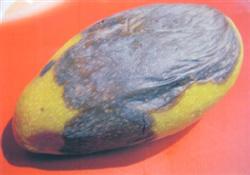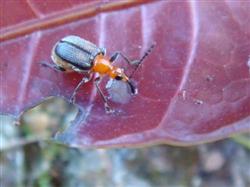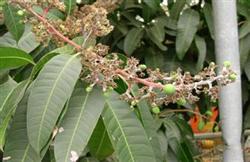Occurrence and control of mango anthracnose

The main results are as follows: 1. the main damage symptoms are mango flowers, fruits and tender shoots. After the young leaves were infected, there were many round brown spots with yellow halo around them, and gradually expanded into round, polygonal or irregular brown spots, and then ruptured and perforated. The leaves and young fruits were easily infected by wounds caused by gall midges, leafhoppers and so on. The seriously susceptible young leaves are easy to bend, the leaf tips and edges are often scorched, and the diseased leaves are easy to fall off. The branches form black spots after they are infected, and then gradually dry up. After infecting the flower ear, there are some small spots, and finally turn black and rot, causing rotten flowers and falling fruit. The fruit is susceptible to disease during the whole growth period, and the young fruit becomes deformed and blackened and falls off after the disease is diseased. After the larger fruit is damaged, black-brown round spots are formed on the pericarp, the center is sunken, the disease part is stiff and deteriorated, and the disease grows pink sticky when the weather is wet. The disease not only does harm in the mango growth period, but also continues to do harm in the fruit storage and transportation period, resulting in a large number of rotten fruits. 2. Pathogen and occurrence regularity anthrax is a disease caused by fungal infection. After overwintering in the diseased part, the pathogen is transmitted by humans, animals, Rain Water, wind and insects, and invades from stomata or wounds of plants or fruits. High humidity is the main cause of anthrax, the relative humidity is more than 95%, and the bacteria invade after 12 hours, and the incubation period is 2-4 days; it can occur all year round. In all parts of Hainan Province, especially in the northeast of Qiongyang, the disease can occur every year from November to April, when the relative humidity is more than 95% and the temperature is 12-30 ℃. Especially when the temperature is 16-25 ℃ and the relative humidity is 95% Mel 100%, anthracnose is the most prone to outbreak, resulting in poor harvest and loss of harvest. Anthracnose pathogen has the characteristics of latent infection, mostly latent in the pericarp and pulp near the petiole, or in the mesophyll near the petiole, about 1mm. 3. Control measures 3.1The diseased branches and leaves were cut off in late autumn and early winter and then burned, and the whole garden was sprayed with 1 ∶ 2 ∶ 100 or 1 ∶ 1 ∶ 100 Bordeaux solution at a time. 3.2 pruning and pruning the summer fruit, pruning and shaping in time to improve the light transmission and ventilation of the plant. The pesticides were sprayed once a week during the flowering period, with chlorothalonil 600x, carbendazim 500x, methylobutrazine 800x, methomyl 400x, Spock EC 1000 times (flower bud stage), 20% chlorine EC 600x (rainy days). At the same time, 0.2% murine 0.3% potassium dihydrogen phosphate, urea and borax are sprayed on leaves every 7-10 days, and flower and fruit protectants are sprayed for 2-3 times in a row, which can effectively enhance the disease resistance of plants. During the fruit period, the following pesticides can be used in rotation, 70% methyl topiramate 700x solution, 1 ∶ 1 ∶ 100Bordeaux solution, 75% chlorothalonil 600x solution, 25% Spoke EC 800x solution, 20% chlorine EC 500x solution. After harvest, soak the fruit in a 1000-fold solution of 70% methyl topiramate (water temperature 52-54 ℃) for 15 minutes, pick it up and place it in a ventilated place to dry, pack it in cartons or bamboo baskets, or move it to a low-temperature CA storage. it can also be sprayed 15 days before fruit harvest and soak the fruit for 15 minutes. The autumn shoot growth period is sprayed every half a month, and the medication is basically the same as the flowering and fruiting period.
- Prev

Control methods of mango weevil
1. Mango leaf-cut weevil is widely distributed, adults feed on mango tender leaves, causing the leaves to dry up, or females lay eggs on the tender leaves and bite off the tender leaves from the base, affecting plant growth. Control method: during the tender shoot growth period, ① picked up the fallen leaves of the injured plants every 3 days, dried them in the sun and burned them, killing young plants.
- Next

Comprehensive control technology of mango soot disease
The main results are as follows: (1) the reason of mango flower and fruit drop is 1. When mango meets low temperature, overcast and rainy weather during flowering and young fruit stage (the temperature is lower than 11.5 ℃) and lasts for a long time, the flower and fruit drop is serious. The flower ear suffers the death, appears a large number of abnormal fruit, aborts the fruit, easy to cause the natural shedding. 2. Diseases and pests harm the pests of mango.
Related
- Moge, come on! The staff of the peasant association in the producing area of cantaloupe were frightened when the crowd gathered.
- Causes and Solutions of low Fruit setting rate of Apple
- Symptoms and control measures of passion fruit virus disease
- Fruit growing lesson: how do apple orchards keep high yields?
- Can you build orchards in the mountains? What are the pros and cons?
- How to manage the coloring period of Crisson grape?
- This paper introduces the processing technology of two kinds of fig products.
- How much is a month for retired teachers in rural areas by 2020?
- How can strawberry planting increase sugar content? We should pay attention to management in many aspects.
- What are the cultivation techniques on how to improve the yield of golden fruit?

